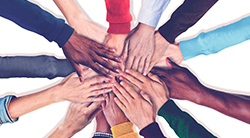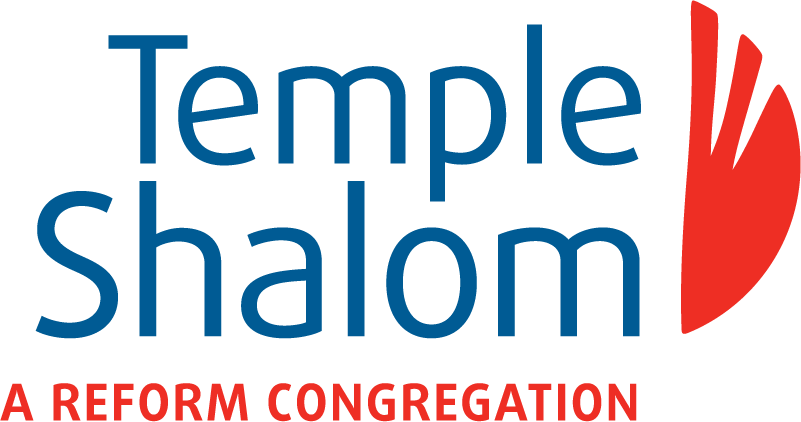Radical Inclusion at Sinai: Yitro, Exodus 18:1–20:23
 We have arrived. All of the stories; all the of the generations between Adam and Eve, and the matriarchs and patriarchs; and 400 years of slavery in Egypt now culminate in the Israelites’ triumphant redemption. They all lead to this singular moment: the Revelation at Sinai. In Parashat Yitro, Moses guides the Israelite people to Mt. Sinai where they encounter God, experiencing all the drama and glory of revelation.
Biblical commentators consistently note that one of the exceptional aspects of the revelation at Sinai is that it is a communal revelation. Every previous moment of revelation in the Torah consists of God speaking privately to an individual or two — Noah, Abraham, Moses, and so on. Private revelation is the most common in other religions as well: an individual experiences God and then shares that revelation more broadly.
But at Sinai, the entire people of Israel are part of the revelation, regardless of age, gender, or ability. Sinai is for everyone. In Exodus 19, Moses assembles the Israelite elders and shares that God wants to create a covenant with the Israelites. They agree, saying “All that the Eternal has spoken, we will do!” (Exodus 19:8). Moses, acting as the intermediary, shares these words with God, and then God confirms a meeting with the entire people: “I will come to you in a thick cloud, in order that the people may hear when I speak with you” (Exodus 19:9). Three days later, “Moses led the people out of the camp toward God, and they took their places at the foot of the mountain” (Exodus 19:17).
The Hebrew word “ha-am” (meaning “the people” or “the nation”) is repeated again and again. You may know the phrase am Yisrael, “the people of Israel,” which is still used in modern Hebrew to mean the Jewish people worldwide in every generation. Ha-am not only refers to the people as a communal entity, but also to all the people, every single individual person.
This Exodus language of inclusivity is remarkably powerful, particularly given that both the Torah and Jewish history haven’t always been so inclusive. One of Reform Judaism’s hallmarks has been pioneering the inclusion of women, LGBTQ+ individuals, and interfaith families. These core tenets are the heirs of Parashat Yitro.
Rabbis of Jewish tradition centuries ago recognized the power of inclusion too. A midrash explained that during the Revelation at Sinai, “Each Israelite heard what was in his power to hear” (Sh’mot Rabbah 28:6). As in all human experiences, no one experienced Sinai in exactly the same way, but everybody was present and participated in the best way they could. This is the Jewish basis for the oft-used contemporary phrase that Jewish communities should “meet people where they are.”
The inclusion of each and every Israelite both in the Exodus from Egypt and at Sinai are powerful models for us today. It wasn’t enough to just bring along each person on the journey; each person had to be present at Sinai, experiencing God’s Presence in thunder, smoke, and rumbling — with whatever senses they could.
Too often today, we think it’s enough to just get everybody in the room together. If we can make our Jewish communities accessible, everyone can come in the door. But that’s not what Parashat Yitro teaches, and it’s not what I learned from my friend and Jewish inclusion expert Matan Koch. Matan writes:
We have arrived. All of the stories; all the of the generations between Adam and Eve, and the matriarchs and patriarchs; and 400 years of slavery in Egypt now culminate in the Israelites’ triumphant redemption. They all lead to this singular moment: the Revelation at Sinai. In Parashat Yitro, Moses guides the Israelite people to Mt. Sinai where they encounter God, experiencing all the drama and glory of revelation.
Biblical commentators consistently note that one of the exceptional aspects of the revelation at Sinai is that it is a communal revelation. Every previous moment of revelation in the Torah consists of God speaking privately to an individual or two — Noah, Abraham, Moses, and so on. Private revelation is the most common in other religions as well: an individual experiences God and then shares that revelation more broadly.
But at Sinai, the entire people of Israel are part of the revelation, regardless of age, gender, or ability. Sinai is for everyone. In Exodus 19, Moses assembles the Israelite elders and shares that God wants to create a covenant with the Israelites. They agree, saying “All that the Eternal has spoken, we will do!” (Exodus 19:8). Moses, acting as the intermediary, shares these words with God, and then God confirms a meeting with the entire people: “I will come to you in a thick cloud, in order that the people may hear when I speak with you” (Exodus 19:9). Three days later, “Moses led the people out of the camp toward God, and they took their places at the foot of the mountain” (Exodus 19:17).
The Hebrew word “ha-am” (meaning “the people” or “the nation”) is repeated again and again. You may know the phrase am Yisrael, “the people of Israel,” which is still used in modern Hebrew to mean the Jewish people worldwide in every generation. Ha-am not only refers to the people as a communal entity, but also to all the people, every single individual person.
This Exodus language of inclusivity is remarkably powerful, particularly given that both the Torah and Jewish history haven’t always been so inclusive. One of Reform Judaism’s hallmarks has been pioneering the inclusion of women, LGBTQ+ individuals, and interfaith families. These core tenets are the heirs of Parashat Yitro.
Rabbis of Jewish tradition centuries ago recognized the power of inclusion too. A midrash explained that during the Revelation at Sinai, “Each Israelite heard what was in his power to hear” (Sh’mot Rabbah 28:6). As in all human experiences, no one experienced Sinai in exactly the same way, but everybody was present and participated in the best way they could. This is the Jewish basis for the oft-used contemporary phrase that Jewish communities should “meet people where they are.”
The inclusion of each and every Israelite both in the Exodus from Egypt and at Sinai are powerful models for us today. It wasn’t enough to just bring along each person on the journey; each person had to be present at Sinai, experiencing God’s Presence in thunder, smoke, and rumbling — with whatever senses they could.
Too often today, we think it’s enough to just get everybody in the room together. If we can make our Jewish communities accessible, everyone can come in the door. But that’s not what Parashat Yitro teaches, and it’s not what I learned from my friend and Jewish inclusion expert Matan Koch. Matan writes:
“Embracing universal inclusion allows us to be ready wherever, whenever, and however people present. It is the excitement of the unknown benefit, the potential of the untapped treasure … ”Matan’s words echo the Sinai message we read in this week’s Torah portion. The Torah doesn’t detail exactly how different people experienced the majesty of revelation. But we do know that, in their own way, “all the people who were in the camp trembled” (Exodus 19:16). In our day, we need to focus not only on what happens in helping people in the door, but also on ensuring that each person can participate in the many aspects of Jewish life. We need to ask ourselves what are the ways that we can make our Jewish lives inclusive in such a way that acknowledges that people experience things in different ways and welcomes them because of that not despite it. It’s also important to note that this radical inclusion at Sinai doesn’t just happen instantaneously. Moses prepares the Israelites for it. God speaks to Moses, sharing the intention of a revelation to the whole people. Moses then shares God’s words with the Israelites and the conversation continues back and forth, culminating in God’s instructions for the Israelites. God gives the Israelites a series of specific instructions for how to prepare for the Revelation (Exodus 19:9-15). The entire people doesn’t just magically appear, ready to absorb God’s Presence. They, like all of us, need time, information, and preparation. No matter their places in Israelite society, each person needs to know, at least broadly, what to expect and what to do. Inclusion needs to go beyond a welcome through the experience itself. Maybe this emphasis on radical inclusion was part of the reason behind God’s decision to give the Torah so publicly. A beautiful midrash says:
Why was the Torah not given in the land of Israel? … Else one might have said: “In my territory the Torah was given.” And another might have said: “In my territory the Torah was given.” Therefore, the Torah was given in the desert, publicly and openly, in a place belonging to no one.” (M’chilta Bachodesh 5, quoted in W. Gunther Plaut, gen. ed., The Torah: A Modern Commentary, rev. ed. [NY: URJ Press, 2005, p. 500)What a compelling reminder for each of us, from those of us who struggle to fit in or find our places in Jewish communities to those of us who lead those communities. No one person owns Judaism or Jewish tradition. It belongs to all of us, no matter our age, sex, race, or ability. That this is the Jewish legacy of God’s revelation (and what more profound moment can there be?) reminds us of the centrality of inclusivity in Jewish tradition and practice.
